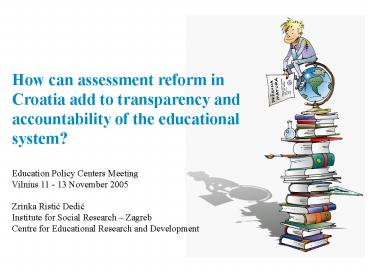Uvodenje dravne mature u hrvatske srednje kole
1 / 10
Title: Uvodenje dravne mature u hrvatske srednje kole
1
- How can assessment reform in Croatia add to
transparency and accountability of
the educational system? - Education Policy Centers MeetingVilnius 11 - 13
November 2005 - Zrinka Ristic Dedic
- Institute for Social Research Zagreb
- Centre for Educational Research and Development
2
Educational Assessment in Croatia the Past and
Present
- educational assessment has been entirely internal
(school based) and teacher-led - schools are not accountable for their results
- no quality control system
- no standardised testing at any educational level
exams are set, administered and marked by the
class teachers - no defined educational standards/ learning
outcomes - substantial variations in expectations and
criteria between different teachers and schools - the same grade does not mean the same level of
achievement lack of trust in the school grades - tertiary institutions set their own entrance
exams as the part of selection procedure for
entrance to the University
3
Perception of Current Educational Assessment
Practice
- students often feel assessment is unfair and
unreliable 44 believed that teachers often give
grades based on previous grades the pupil
received and 29 based on student social
background or social relations with the teacher
(CERD research 2003) - secondary school teachers are aware that grades
are not valid and reliable indicator of pupils
success in school. Each teacher sets her own
standards and evaluate pupils performance
against them. - higher educational institutions are not satisfied
with the readiness of their freshmen and
acknowledge the differences in prior knowledge
between students from different schools. - educational experts claimed that the
non-existence of the quality control system
combined with low autonomy of the schools
produces low level of accountability of the
schools and discourages quality improvement
attempts (Openness in Education OSI 2005)
4
Educational Assessment the Near Future
Three Pillars of Assessment Reform
- Final exams in the secondary schools (State
Matura) - 2008/09 the first State Matura in gymnasiums
- 2009/10 the first State Matura in vocational 4
yr schools - National assessment
- 2005/06 Croatian language, English language and
Maths tests for first year gymnasium students - School self evaluation
- In parallel with national assessment
5
The Proposed Model External Assessment
- FINAL EXAMS STATE MATURA
- external school leaving exams
- certification function
- gatekeeper - selection purpose (very likely)
- conceptualised under the paradigm of outcome
based education - NATIONAL ASSESSMENT
- monitoring of school system efficacy used for
providing information about the performance of
the system - student monitoring (formative assessment)
- preparing the system for introduction of State
Matura - setting norms and grading standards
- pre-testing the items
6
The Proposed Model School Self-Evaluation
- complementary system for quality improvement
- external evaluation achieves the best results if
balanced with self-evaluation system - finding specific approaches and procedures for
the realisation of educational standards
established within external evaluation system - helping schools in the process of self-analysis,
in the determining of developmental priorities,
setting goals and developing plans for action - allowing schools to independently create their
own development - autonomy and responsibility back to the schools
- improvement of the quality within and from the
bottom
7
Accountability Issues
- Schools are obliged to use the information they
receive through national assessment and Matura
exams and combine these information with other
educational quality indicators in order to
continuously self-analyse and self-evaluate their
work. - outcome based approach sets the norms for the
product (i.e. learning outcomes), but not for the
teaching process and contents - school self evaluation methodology gives the
schools substantial autonomy in planning the
progress and a full responsibility for the
monitoring of the quality and for taking
developmental actions - this approach provides a significant contribution
to the democratisation and transparency in the
education system
8
Transparency Issues
- transparent learning outcomes and grading
criteria - test specifications prepared 2 years
in advance - transparency in exam preparation - published
specimen paper, all rules set in advance - transparency in conduct of the examinations
clear and publicized regulations - transparency in certification clear and
comparable diploma on the local and European
market - transparency in the usage of results every
school and student gets his/her own results and
could compare it to national average. - League tables as a total transparent measure are
not welcome, however!
9
Corruption Issues
- Perception of corruption in education 22.5
claimed that corruption is widespread in
pretertiary education and 54.2 in tertiary
(TRANSPARENCY INTERNATIONAL 2004) - 6.5 students reported that they were offered to
buy the vacancy at the University 2,6 students
paid the bribe. (MONITOR STATISTICA 2003 - 2004) - new assessment policy promotes the value of
fairness and equal opportunities for all - test preparation procedures and the conduct of
the examinations eliminate the possibility of
unfair or corruptive practices - inflation of As phenomenon will loose its
function - rank of candidates for university entrance will
be determined by a unique list for all the
faculties at the NCEEE - this will ensure more valid and fair selection of
candidates for enrolment into tertiary education.
Selection procedures for university entrance will
be more transparent issues with the regularity
of entrance exams will disappear.
10
Conclusions
Assessment reform introduction of external
evaluation and self evaluation - will inevitably
impact the deep transformation of Croatian
education system. Academic performance will be
measured in a more valid, reliable, objective and
fair way. Assessment reform will help in
promoting quality in education. It will establish
quality assurance and quality control procedures.
It will raise the level of responsibility of
all stakeholders in the educational system. It
will add to transparency of the system by setting
clear national standards, defining the
educational aims and outcomes, and making
secondary education certificates transparent,
recognizable and comparable. It might serve as an
anti-corruption measure.

